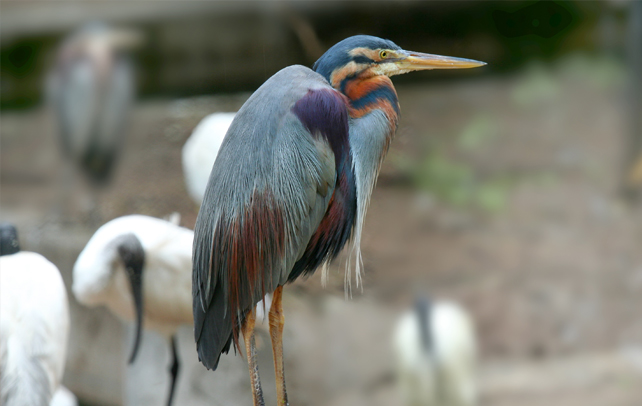Interesting Information About Siberian Crane

Siberian crane, the long necked graceful creature is a delight to watch, especially when it does the fishing trick, slinging a fish into air and catching it in its beak before gulping it down. But, unfortunately, only around 3,000 are left of these regal creatures. With natural red skinned mask on their faces, as if to hide their grieving faces, these naive birds have been, in the past, hunted for their flesh and game. Thankfully, after these birds were officially declared protected species; their hunting went down, and their numbers went up. These birds need a specific kind of environment to survive which makes them all the more vulnerable. It’s up to us, the people, to educate the rest and these beautiful birds from getting extinct. The following section is an attempt to make you understand the inherent godly charisma that these birds possess. Have a read; save a crane!
Fast Facts
Binomial Name: Grus leucogeranus
Kingdom: Animalia
Phylum: Chordata
Class: Aves
Order: Gruiformes
Family: Gruidae
Genus: Grus
Species: G. leucogeranus
Height: 140 cm, 5 ft.
Weight: 4.9 to 8.6 kg
Population: 2,900 to 3,000
Trend: Critically Endangered, Population in Rapid decline
Diet: Omnivorous (Plants, Small Rodents, Earthworms, and Fish)
Habitat: Wetlands & Marshlands
Average Clutch Size: 2
Predators: Fox, Eagle, Wildcats
Wing Span: 2.1 to 2.3 m
Average Age: 15 to 30 years
Interesting And Fun Facts About Siberian Crane
- It is quite easy to spot a Siberian crane out of a flock of birds because of its unique red coloured mask which covers its fore crown, forehead, face and sides of the head, ending at the back of the eyes.
- Though it is easy to distinguish this species of crane from others, it is really difficult to distinguish a male from a female Siberian crane. Both are of almost the same size and have similar features; it is just that the female crane is a little smaller in size and has a little shorter beak.
- Siberian crane is white in colour, mostly because of the pure white plumage. The colour of its eyes is a pale yellow, while the legs and toes are of reddish colour.
- These birds only attain white plumage with age. Juveniles have a black primary plumage till they mature into adults. The heads and necks of these young cranes are rusty buff in colour while the rest of their bodies are covered with feathers of buffy brown and light coloured feathers on throat and chin.
- Also, juveniles, at the time of birth, have beautiful little blue eyes. However, as they grow up their eye colour changes to light yellow, approximately after six months.
- Siberian cranes, as the name suggests, are native to Siberia. Though earlier, these birds also used to populate the central region of Siberia, but now, they are only restricted to the eastern and western parts.
- This is perhaps, the most demanding among the species of cranes, and needs highly specialized habitat and food, making them all the more vulnerable. They need aquatic environments such as wetlands and marshes to breed, feed and roost.
- The mating season for these fowls start from May and lasts till June. Their mating calls are a set of coordinated body movements and sounds, with which they attract their partners. Siberian cranes stand in a specific posture, throw their heads back and point their beaks skywards. The difference between male and female’s posture is that a male lifts up its wings over its back while making a mating call, whereas, a female keeps its wings folded by its side.
- The Siberian cranes make their nests in bogs, marshes and other wetlands where the water is fresh and the visibility is good. The female lays two eggs on an average and then these eggs are incubated for 29 days by both, the male and female crane. The chicks take 70-80 days to take first flight.
- Siberian cranes are omnivores in nature but it is noted that most times, with exceptions of breeding season, these creatures depend mostly on a vegetarian diet. Because of their abilities to easily dig into wet soil these fowls are easily able to excavate nutritive roots and tubers from the wetlands. Some have also been observed to feed on earthworms and small insects.
- These birds are highly vulnerable mostly because their habitats are being intruded by humans. Because of the rising population of humans, it has become inevitable to not expand into the wilds. Another reason behind the dipping population of these creatures is that they have been hunted down on their migrating route for game and their meat.
- They are migratory birds and migrate to all tropical countries with warmer winters. The winters are cold in their native places: Russia and Siberia, so they fly east in search of warmer climate. Hence, these birds travel to a number of south-east Asian countries including India. Bharatpur Bird Sanctuary in Rajasthan is famous for the migratory Siberian cranes.
- To reach the wintering grounds these cranes have to fly at high altitudes, mainly to cross the mighty Himalayan ranges.
- During the earlier years under the British Raj, both, the British generals and Indian maharajas plundered the naïve fowls. It is recorded that the then Governor-General of India, Lord Linlithgow, who was accompanied by Bharatpur’s Maharaja, bagged 4,273 water birds in one day, which mostly included the Siberian cranes.









